The Best and Worst Fences For Dogs
By Michele Welton, Dog Trainer, Breed Selection Consultant, Author of 15 Dog Books
Fencing needed for confinement
Risk of Aggression Toward People
Risk of Aggression Toward Other Dogs
Fencing – keeping a dog confined
What's the fencing situation in your yard?
When it comes to keeping the majority of dogs safe, certain kinds of fences are better than others. If you have the best fencing, there are more breeds available for you to choose from. If you have different fencing, you should exclude some breeds from your consideration.
As responsible owners, we should only choose a dog who is likely to remain safe inside the particular kind of fencing we can provide.
Traditional privacy fence
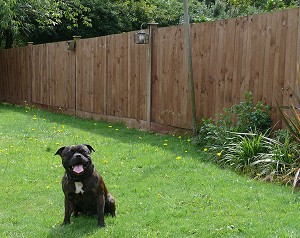
This Staffordshire Bull Terrier belongs to a family of dogs that can be aggressive toward other dogs. They're best contained with a solid privacy fence.
The safest fence is a solid privacy fence, usually wood or vinyl.
- Solid fencing blocks your dog's view of the world, which makes him less likely to bark at (or charge towards) passing people and dogs.
- Solid fencing hides your dog from view so he is less likely to be stolen or teased.
- Solid fencing is much harder to climb than chain link or wire.
See-through fencing (chain link, wire mesh, pickets, wrought iron)
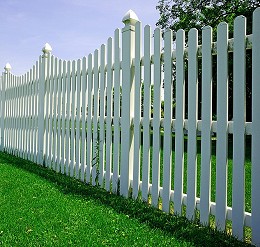
Pickets are one type of see-through fence.
- See-through fencing encourages dogs to bark at (or charge toward) people and dogs passing by. If see-through fencing runs along a sidewalk traversed by other people/dogs, I don't recommend breeds that tend toward excitable barking (Norwegian Elkhounds, Shelties, Corgis...), or suspiciousness toward strangers (Rottweilers, Cane Corsos...), or aggression toward other dogs (Pit Bulls, Akitas...).
- See-through fencing leaves your dog more vulnerable to being teased or stolen.
- See-through fencing leaves you more open to legal liabilities if someone sticks their hand through it and gets bitten. So again, I wouldn't recommend putting a potentially aggressive breed behind this fencing unless there are no passersby in your setting.
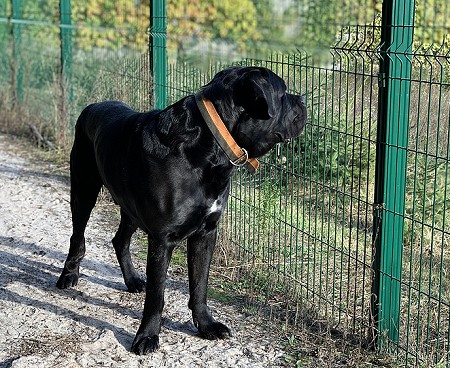
I don't recommend keeping a barky breed, or a potentially suspicious or aggressive breed (like this Cane Corso), behind a see-through wire fence unless your setting is so private that no one walks by.
- See-through fencing can be dangerous if you choose a breed who can squeeze through the openings. Remember that puppies and adolescents are usually much slimmer than adults and can squirm through amazingly narrow gaps. You should run a strip of small-mesh chicken wire across the gaps, if necessary.
- See-through fencing is climbable, so I don't recommend nimble escape artists like Siberian Huskies, Shibas, Basenjis, Border Collies, Miniature Pinschers, Jack Russells (and other agile terriers), and Beagles, among others.
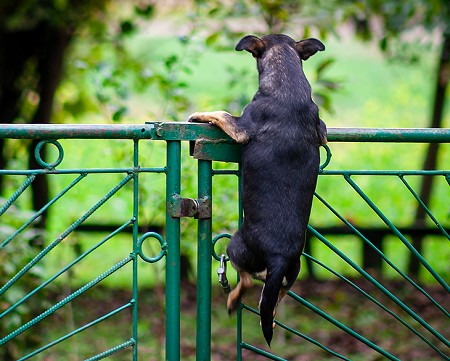
Terrier mixes can be both nimble and adventurous. I don't recommend them for climbable fencing.
To be fair, see-through fencing can be fine IF you get a dog who can't climb it or squeeze between the gaps; and IF your yard is located in a private setting with no passersby (or IF you add dense plantings that block the view).
The HEIGHT of your fence matters
Don't measure the height of your fencing at its tallest point, but at the lowest point accessible to the dog. Many dogs are very clever about making their escape attempt from the lowest/weakest point. Make sure there are no objects close to the fence (a tree stump or heavy-duty storage container) that your dog might scramble onto and use as a springboard.
If your fence is less than 6 feet
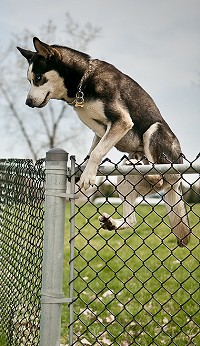
Siberian Huskies need high solid fences, as these canine escapists can both jump and climb.
I don't recommend breeds that are athletic jumpers. For example, Siberian Huskies (and similar spitz breeds), Whippets (and other sighthounds), Fox Terriers (and other agile, long-legged terriers), Poodles (and their crossbred "doodle" or "poo" cousins).
I once watched a small Italian Greyhound square off against a 7 foot solid fence. He didn't even make a running start. He simply crouched, then soared effortlessly skyward, hooked his front feet over the top of the fence, and did a remarkable chin-up that poured him over the top and down the other side. Took 4 seconds. Maybe less.
If your fence is less than 4 feet
I recommend sticking with tiny, small, and midsized breeds – but only those breeds that are NOT jumpers or climbers.
If you're determined to keep a serious escape artist... think prison yard containment. Start with a high solid fence and install an overhang all around the top. This consists of 12- to 18-inch steel extension bars attached to the top of the fence, angled inward at 45-degrees, and strung with chicken wire.
Will this keep every dog confined? No... some determined dogs must be secured in an enclosure completely roofed over with wire mesh. And don't forget dogs can dig under fencing, as well!
If your dog is a digger
Walk around the inside perimeter and study the bottom of the fence where it meets the ground. Some dogs can crawl under a surprisingly small gap!
To deter serious diggers, line the inside perimeter with landscape timbers or patio blocks. Or dig a trench along the inside perimeter, then fill it with concrete or attach a strip of chicken wire or garden fencing to the bottom of the fence, burying the lowest few inches in the trench.
Alternative fencing
What if you don't have a traditional fenced yard? Suppose you only have...
- an invisible/electronic fence.
- a freestanding kennel run or pen (usually chain link or wire).
- a tether connected to a stake or cable/pulley system.
- or maybe... you don't have any kind of fenced yard.
In all these cases, see my article: Do dogs need a fenced yard?
Finally, don't put your dog in a position to escape or to bark at or charge toward passersby. Simply don't leave him outdoors unless you're home AND you're outside with him, or inside but watching him closely, prepared to go out immediately if he starts doing something inappropriate. In other words, don't allow a bad behavior to become a bad habit.
My best-selling books – now available FREE on my website
 Respect Training For Puppies: 30 seconds to a calm, polite, well-behaved puppy is for puppies 2 to 18 months old. Your puppy will learn the 21 skills that all family dogs need to know. Click here to read for free.
Respect Training For Puppies: 30 seconds to a calm, polite, well-behaved puppy is for puppies 2 to 18 months old. Your puppy will learn the 21 skills that all family dogs need to know. Click here to read for free. Teach Your Dog 100 English Words is a unique Vocabulary and Respect Training Program that will teach your adult dog to listen to you and do what you say. Click here to read for free.
Teach Your Dog 100 English Words is a unique Vocabulary and Respect Training Program that will teach your adult dog to listen to you and do what you say. Click here to read for free. 11 Things You Must Do Right To Keep Your Dog Healthy and Happy helps your dog live a longer, healthier life. Get my honest advice about all 11 Things before you bring home your new puppy, because some mistakes with early health care cannot be undone. Click here to read for free.
11 Things You Must Do Right To Keep Your Dog Healthy and Happy helps your dog live a longer, healthier life. Get my honest advice about all 11 Things before you bring home your new puppy, because some mistakes with early health care cannot be undone. Click here to read for free.
